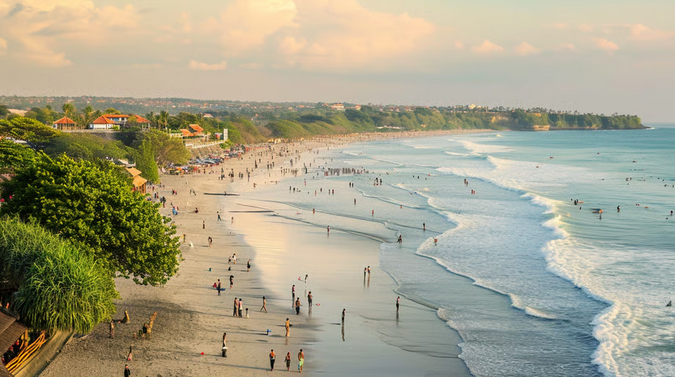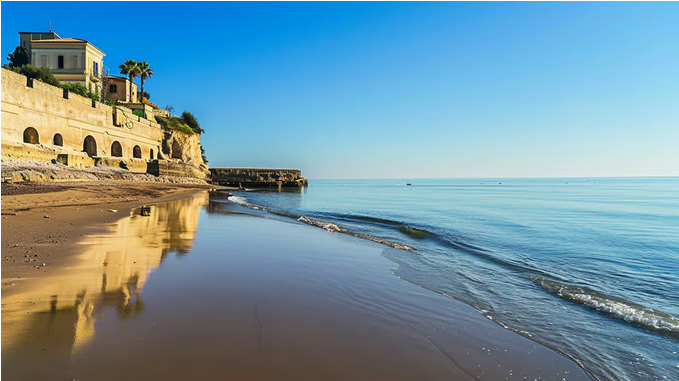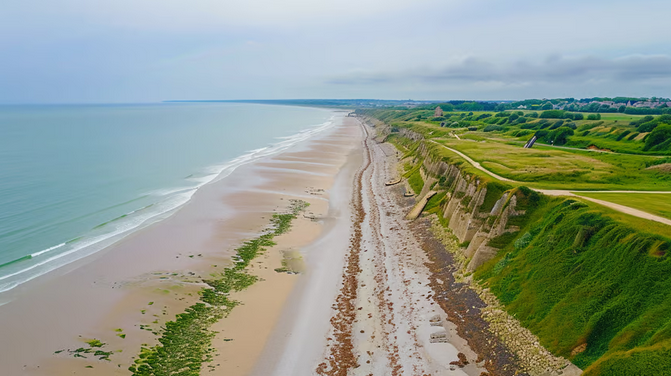Timeless Tides: Historical Beaches that Have Witnessed Centuries
Walk along the shores of historical beaches that have stood the test of time, each wave echoing tales from centuries past, offering a unique blend of natural beauty and historical resonance.
1/4/20249 min read

Beaches, with their golden sands and sparkling waters, have always been a beloved destination for people seeking relaxation and rejuvenation. However, many of these beautiful coastal stretches have a deeper significance beyond their aesthetic appeal. They have borne witness to centuries of human history, silently recording the rise and fall of civilizations, the battles fought and lost, and the cultural and spiritual traditions that have shaped our world.
Understanding the Historical Significance of Beaches
When we think of historical sites, beaches may not immediately come to mind. However, these coastal areas have played crucial roles in the development of ancient civilizations and the unfolding of world-changing events.
Beaches, with their vast stretches of sand and proximity to the sea, have always been a source of fascination and inspiration for humans. They have served as meeting points for different cultures, witnesses to trade and transportation activities, and strategic locations in times of war.
The Role of Beaches in Ancient Civilizations
From the ancient Egyptians to the Greeks and Romans, beaches held great importance in the daily lives and rituals of these early civilizations. In Egypt, the beaches along the Nile River witnessed trade and transportation activities. Merchants would dock their boats along the sandy shores, unloading exotic goods from distant lands. The beaches became bustling hubs of commerce, connecting Egypt to the wider world.
Similarly, the Greeks and Romans utilized coastal areas as ports for their maritime trade. The beaches served as gateways to the sea, enabling the exchange of goods, ideas, and cultures. These ancient civilizations recognized the strategic value of beaches, establishing thriving coastal cities that became centers of trade and innovation.
Beaches as Strategic Locations in Wars
The strategic significance of beaches is evident in several historical battles. One notable example is the D-Day landings on the beaches of Normandy during World War II. These beaches, codenamed Juno, Sword, Gold, Utah, and Omaha, were the sites of intense fighting as Allied forces sought to liberate Europe from Nazi control.
The planning and execution of the D-Day landings were meticulous, with every detail taken into account. The choice of beaches was crucial, as they provided the necessary access points for the invasion. The sandy shores of Normandy became the backdrop for one of the largest amphibious assaults in history, marking a turning point in World War II.
But it's not just the D-Day landings that highlight the importance of beaches in warfare. Throughout history, coastal areas have been sought after for their strategic advantages. Their wide open spaces and proximity to the sea make them ideal landing zones for military operations. From ancient naval battles to modern amphibious assaults, beaches have witnessed the ebb and flow of armies, shaping the course of history.
So, the next time you find yourself strolling along a beach, take a moment to appreciate its historical significance. From ancient civilizations to pivotal moments in world history, beaches have played a remarkable role in shaping our past and present.

The Evolution of Iconic Beaches Through Time
Over the centuries, beaches have witnessed not only the ebb and flow of human activity but also dramatic geological changes that have shaped their landscapes.
Beaches, with their pristine sands and mesmerizing waves, have always captivated the human imagination. They are not only a place of relaxation and recreation but also a testament to the ever-changing nature of our planet. From the shifting sands to the powerful forces of nature, beaches are constantly evolving, adapting, and transforming.
Geological Changes and Their Impact
Natural phenomena such as earthquakes, tsunamis, and coastal erosion have altered the appearance of many iconic beaches. These geological events, occurring over thousands of years, have left their mark on the coastal landscapes, creating unique and awe-inspiring features.
Take, for example, the Great Barrier Reef in Australia. This world-renowned natural wonder has undergone a remarkable transformation over millennia. The changing sea levels and the growth of coral reefs have shaped its intricate and diverse ecosystem. The once shallow lagoon has now become a complex network of reefs, islands, and channels, attracting millions of visitors each year.
Similarly, the stunning beaches of Hawaii have been shaped by volcanic activity. The islands, born from the fiery depths of the Earth, have left behind a legacy of black sand beaches, formed by the rapid cooling of lava as it meets the ocean's edge. These unique beaches, such as Punalu'u Beach on the Big Island, offer a striking contrast to the golden sands typically associated with tropical paradises.
Human Influence on Beach Landscapes
While nature has played a significant role in shaping beaches, human activity has also left its mark on these coastal landscapes. The construction of harbors, coastal developments, and erosion control measures have altered the natural flow of sand and affected the overall health of beach ecosystems.
One such example is the Florida Keys, a string of islands renowned for their stunning beaches and vibrant marine life. However, the rapid development and urbanization of the area have taken a toll on its delicate balance. The construction of resorts, marinas, and waterfront properties has disrupted the natural sediment flow, leading to erosion and the loss of beachfront habitats.
Recognizing the importance of preserving these iconic beaches, conservation efforts have been initiated to restore and protect the fragile ecosystems of the Florida Keys. Through beach nourishment projects, dune restoration, and the implementation of sustainable coastal management practices, steps are being taken to ensure the long-term viability of these cherished coastal treasures.
It is essential to strike a balance between human enjoyment and the preservation of these natural wonders. By understanding the complex interplay between geological processes, human intervention, and the delicate ecosystems that thrive on beaches, we can work towards a future where iconic beaches continue to captivate and inspire generations to come.
Cultural and Spiritual Importance of Beaches
Beyond their historical significance, beaches have held profound meaning in the cultural and spiritual practices of various civilizations throughout time.
Beaches, with their vast expanse of sand and the rhythmic crashing of waves, have captivated the human imagination since ancient times. They have been the backdrop for countless stories, myths, and legends, woven into the very fabric of human culture.
Beaches in Mythology and Folklore
Mythology and folklore often speak of beaches as liminal spaces where the boundaries between the earthly and divine worlds blur. For instance, in Greek mythology, the beach was considered the realm of Poseidon, the god of the sea and earthquakes, who held power over sailors and seafarers. It was believed that the crashing waves and shifting sands were manifestations of his immense power.
Similarly, in Norse mythology, the beach was seen as a gateway to other realms. It was believed that the souls of the departed would journey across the sea to reach the afterlife, guided by the light of the setting sun as it dipped below the horizon.
Beaches have also been associated with mermaids and other mythical creatures. Legends tell of beautiful sirens who would lure unsuspecting sailors to their doom with their enchanting songs. These tales serve as cautionary reminders of the treacherous nature of the sea and the allure of the beach.
Beaches as Sacred Sites in Various Cultures
Beaches have been revered as sacred locations in many cultures. The Ganges River delta in India, where the sacred river meets the Bay of Bengal, is believed to be a place of spiritual cleansing. Pilgrims flock to this beach to partake in rituals and ceremonies, seeking solace and redemption. Here, the convergence of the sacred river and the vast ocean symbolizes the union of the individual soul with the divine.
In ancient Egypt, the beach held great significance as well. The annual flooding of the Nile River would deposit rich silt onto the nearby beaches, rejuvenating the land and ensuring a bountiful harvest. The beach became a symbol of fertility and abundance, and rituals were performed to honor the river and its life-giving properties.
For indigenous cultures around the world, beaches have been places of connection with nature and the spiritual realm. The rhythmic sound of the waves crashing against the shore is believed to carry messages from the ancestors and the spirits of the sea. These cultures have developed intricate rituals and ceremonies to honor and communicate with these powerful forces.
From ancient myths to modern-day traditions, beaches continue to hold a special place in the hearts and minds of people around the world. They are not merely stretches of sand and water, but gateways to the unknown, realms of mystery and wonder. The cultural and spiritual importance of beaches is a testament to the enduring power of nature and its ability to inspire and transform the human spirit.

Beaches as Witnesses to Historical Events
Throughout history, beaches have been the backdrop for significant events that have shaped the course of human civilization. These sandy shores have not only provided a picturesque setting for leisure and relaxation but have also played a pivotal role in witnessing and hosting historical events that have left an indelible mark on our world.
Famous Historical Events that Occurred on Beaches
Beaches have witnessed the signing of treaties, the landing of explorers, and moments of triumph and tragedy. One such remarkable event that took place on a beach was the signing of the Treaty of Waitangi on the shores of New Zealand. This historic treaty, signed on February 6, 1840, between the indigenous Māori chiefs and the British Crown, marked the beginning of British colonization and the establishment of modern New Zealand as we know it today. The sandy beach served as a symbolic meeting place where two cultures converged, shaping the future of the nation.
Another significant historical event that unfolded on a beach was the landing of explorers. The sandy shores of San Salvador Island in the Bahamas witnessed the arrival of Christopher Columbus on October 12, 1492. This momentous event marked the beginning of European exploration and the eventual colonization of the Americas. The beach, with its pristine beauty and untouched nature, became the first point of contact between the Old and New Worlds, forever altering the course of history.
Beaches and Their Role in Maritime History
Beaches have not only been witnesses to historical events but have also played a crucial role in maritime history. These sandy stretches of land have served as crucial ports and harbors, facilitating trade, exploration, and the expansion of empires. One such beach that holds immense historical significance is the ancient city of Alexandria in Egypt.
Alexandria, with its famous Lighthouse of Alexandria, was a thriving hub of maritime activity in ancient times. The beach acted as a gateway connecting the East and West, serving as a vital link for trade and cultural exchange. The Lighthouse of Alexandria, one of the Seven Wonders of the Ancient World, stood tall on the beach, guiding ships and sailors to the bustling city. This magnificent structure not only served as a beacon of light but also as a symbol of the city's grandeur and influence in the ancient world.
The beaches of Alexandria witnessed the arrival of merchants from distant lands, bringing with them exotic goods, ideas, and knowledge. The bustling port city became a melting pot of cultures, where Egyptian, Greek, Roman, and various other civilizations converged. The beach, with its golden sands and gentle waves, became a meeting point for people from different corners of the world, fostering a rich exchange of ideas, arts, and philosophies.
In conclusion, beaches have played a profound role in human history, serving as witnesses to significant events and shaping the course of civilizations. From the signing of treaties to the landing of explorers, these sandy shores have seen triumphs and tragedies unfold. Furthermore, beaches have acted as vital ports and harbors, facilitating trade, exploration, and cultural exchange. As we walk along the beaches today, let us remember the historical significance they hold and the stories they silently tell.
Conservation Efforts for Historical Beaches
As we recognize the historical, cultural, and ecological value of these stunning locations, it is essential to safeguard them for future generations.
Threats to Historical Beaches
Historical beaches face various threats, including coastal development, pollution, rising sea levels, and climate change. These factors can erode the beauty and historical integrity of these sites, putting them at risk of irreversible damage.
The Importance of Preserving Historical Beaches
Preserving historical beaches is not merely about protecting their visual appeal – it is about honoring our shared human heritage. Through preservation efforts, we can ensure that future generations can discover and learn from these historical treasures, fostering a sense of connection and understanding with the past.
Conclusion
Historical beaches are more than just picturesque landscapes; they are living witnesses to the triumphs and tragedies, the wisdom and folly of human history. By valuing and protecting these timeless tides, we can keep the stories of the past alive for generations to come. Whether by participating in beach clean-ups, supporting conservation organizations, or simply spreading awareness, each of us can play a role in preserving the historical beaches that have shaped our world. Let us honor their legacy and ensure that these coastal treasures continue to inspire and educate for centuries to come.